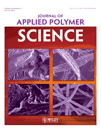Organic liquid stimuli-response behaviors of electrically conductive microfibrillar composite with a selective conductive component distribution
Abstract
This article reports the organic liquid stimuli-response behaviors of carbon black (CB)-filled electrically conductive microfibrillar poly(ethylene terephthalate) (PET)/polyethylene (PE) composite (FCMC) with CB particles selectively localized at PET microfibrils' surfaces. It was found that FCMC's thickness and CB concentration affected its responsivity significantly, a thinner FCMC film with a high CB content exhibited higher responsivity and better signals. In immersion-drying tests, FCMC displayed high and stable responsivities after six immersion-drying runs, indicating that the solvent absorption/desorption equilibrium state was achieved. After long-term immersion, FCMC showed obviously different organic liquid stimuli-response behaviors with faster response rate in immersion and higher terminal resistivity platform in drying, compared with samples without immersion treatment. Conductive network's microstructural changes induced by the long-term immersion and evident capillary effect, which resulted in slow evaporation of remaining solvent in FCMC's interfaces, are the reasons for the phenomenon. © 2011 Wiley Periodicals, Inc. J Appl Polym Sci, 2011




